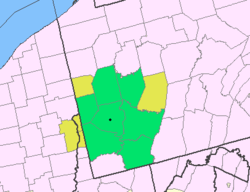Ligonier, Pennsylvania
Ligonier, Pennsylvania | |
|---|---|
 Ligonier, Pennsylvania | |
|
EDT) | |
| ZIP code | 15658 |
| Area codes | 724, 878 |
| FIPS code | 42-43232 |
| School District | Ligonier Valley School District |
| Website | www |
Ligonier is a
Ligonier is the site of a reconstruction of Fort Ligonier, an example of a frontier fort of the French and Indian War. Ligonier is also known for its downtown square, the Diamond, which has a bandstand in the middle.
History
In 1758, when British forces launched a major campaign to remove

In 1817, the Philadelphia-Pittsburgh Turnpike was completed, a gravel road that was the precursor to today's
However, in 1852 the Pennsylvania Railroad was completed, which bypassed Ligonier and passed through the towns of Bolivar and Latrobe instead. Traffic shifted from horse-drawn vehicles to the railroad, causing the community's population to drop to 350 according to the 1860 census.[8]
Ligonier benefited when the Ligonier Valley Railroad was completed in 1877, linking the community to Latrobe where connections to the Pennsylvania Railroad were possible.[9] The Ligonier Valley Railroad enabled lumber, coal, and quarried stone to be transported out of the Ligonier Valley, which spurred development of the town. Additionally, the railroad made it easier for Pittsburgh residents to visit Ligonier, causing the town to develop as a summer resort. Some major physical changes to Ligonier occurred during this period. In 1894, the Diamond, which had been used as a corral for horses and wagons, was transformed into a park with a bandstand. A large hotel, the Hotel Breniser, was built in 1900 where the town hall currently sits.[8][10] In 1909–1910, the Ligonier Valley Railroad built an ornate station and headquarters building, which still stands at 339 West Main Street.
In 1952, the Ligonier Valley Railroad ceased operation, due to a combination of
The Pittsburgh, Westmoreland and Somerset Railroad also served Ligonier from 1899 to 1916, although it did not enjoy the success of the Ligonier Valley Railroad.
Ligonier has three listings on the National Register of Historic Places: the Fort Ligonier site at 216 South Market Street; the Ligonier Historic District, which encompasses the Diamond and the oldest parts of the borough; and the demolished Ligonier Armory.[11]
Ligonier and its surrounding countryside are strongly associated with the Mellon banking family, who still owns considerable tracts of land in the area. The Huntland Downs estate, near Ligonier, comprises some 30,000 acres (100 km2) of land and is the centerpiece of the Mellon land holdings in the region.
-
Former train station, now school district offices
-
Fort Ligonier
-
Ligonier's downtown with the Town Hall in the background.
Media
Ligonier is served by two media markets:
Demographics
| Census | Pop. | Note | %± |
|---|---|---|---|
| 1840 | 294 | — | |
| 1850 | 378 | 28.6% | |
| 1860 | 351 | −7.1% | |
| 1870 | 317 | −9.7% | |
| 1880 | 634 | 100.0% | |
| 1890 | 782 | 23.3% | |
| 1900 | 1,259 | 61.0% | |
| 1910 | 1,575 | 25.1% | |
| 1920 | 1,807 | 14.7% | |
| 1930 | 1,978 | 9.5% | |
| 1940 | 2,111 | 6.7% | |
| 1950 | 2,160 | 2.3% | |
| 1960 | 2,276 | 5.4% | |
| 1970 | 2,258 | −0.8% | |
| 1980 | 1,917 | −15.1% | |
| 1990 | 1,638 | −14.6% | |
| 2000 | 1,695 | 3.5% | |
| 2010 | 1,573 | −7.2% | |
| 2020 | 1,513 | −3.8% | |
| Sources:[12][13][14][2] | |||
As of the
Geography
The Borough of Ligonier is entirely surrounded by
Notable people
- Arthur St. Clair, Major General and Patriot in the revolutionary war, 9th President of the Continental Congress (see also Fort Ligonier)
- Garrett Smithley, NASCAR driver
- R.K. Mellon, Financier
- RC Sproul, Reformed Theologian and founder of Ligonier Ministry
See also
References
- ^ "ArcGIS REST Services Directory". United States Census Bureau. Retrieved October 12, 2022.
- ^ a b "Census Population API". United States Census Bureau. Retrieved October 12, 2022.
- ^ a b "U.S. Census website". US Census Bureau. 2020. Retrieved September 26, 2022.
- ^ "Metropolitan Areas and Components". Population Division, US Census Bureau. 1999. Retrieved February 2, 2010.
- ^ Gannett, Henry (1905). The Origin of Certain Place Names in the United States. U.S. Government Printing Office. p. 186.
- ISBN 0-7385-0535-8.
- ^ "History - Ligonier Valley Chamber of Commerce". Ligonier Valley Chamber of Commerce. Retrieved August 7, 2017.
- ^ a b "National Register of Historical Places - Ligonier Historic District" (PDF). ARCH: Pennsylvania's Historic Architecture & Archeology. Pennsylvania Museum and Historical Commission. Retrieved May 4, 2008.
- ^ "Ligonier Valley Rail Road Association".
- ISBN 978-0-7385-5729-8.
- ^ "National Register Information System". National Register of Historic Places. National Park Service. July 9, 2010.
- ^ "Census of Population and Housing". U.S. Census Bureau. Retrieved December 11, 2013.
- ^ a b "U.S. Census website". United States Census Bureau. Retrieved January 31, 2008.
- ^ "Incorporated Places and Minor Civil Divisions Datasets: Subcounty Resident Population Estimates: April 1, 2010 to July 1, 2012". Population Estimates. U.S. Census Bureau. Archived from the original on June 11, 2013. Retrieved December 11, 2013.
- ^ "Population and Housing Unit Estimates". United States Census Bureau. May 24, 2020. Retrieved May 27, 2020.
- ^ "US Gazetteer files: 2010, 2000, and 1990". United States Census Bureau. February 12, 2011. Retrieved April 23, 2011.





